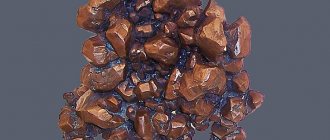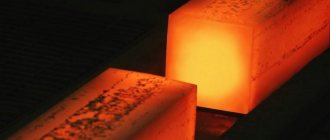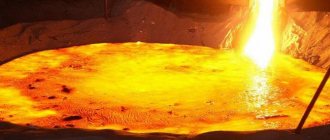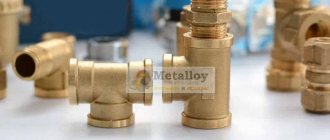Density of metals
Table of density ρ of materials g/cm3 (kg/dm3) and coefficients K = ρ/7.85*
* According to the reference book P.M. Polivanov, E.P. Polivanova. Tables for calculating the mass of parts and materials: Handbook. 13th edition, 2006 (revised in accordance with GOST standards).
| Group name | Name of material, brand | ρ | TO |
| PURE METALS | |||
| Pure metals | Aluminum | 2,7 | 0,34 |
| Beryllium | 1,84 | 0,23 | |
| Vanadium | 6,5-7,1 | 0,83-0,90 | |
| Bismuth | 9,8 | 1,24 | |
| Tungsten | 19,3 | 2,45 | |
| Gallium | 5,91 | 0,75 | |
| Hafnium | 13,09 | 1,66 | |
| Germanium | 5,33 | 0,68 | |
| Gold | 19,32 | 2,45 | |
| Indium | 7,36 | 0,93 | |
| Iridium | 22,4 | 2,84 | |
| Cadmium | 8,64 | 1,10 | |
| Cobalt | 8,9 | 1,13 | |
| Silicon | 2,55 | 0,32 | |
| Lithium | 0,53 | 0,07 | |
| Magnesium | 1,74 | 0,22 | |
| Copper | 8,94 | 1,14 | |
| Molybdenum | 10,3 | 1,31 | |
| Manganese | 7,2-7,4 | 0,91-0,94 | |
| Sodium | 0,97 | 0,12 | |
| Nickel | 8,9 | 1,13 | |
| Tin | 7,3 | 0,93 | |
| Palladium | 12,0 | 1,52 | |
| Platinum | 21,2-21,5 | 2,69-2,73 | |
| Rhenium | 21,0 | 2,67 | |
| Rhodium | 12,48 | 1,58 | |
| Mercury | 13,6 | 1,73 | |
| Rubidium | 1,52 | 0,19 | |
| Ruthenium | 12,45 | 1,58 | |
| Lead | 11,37 | 1,44 | |
| Silver | 10,5 | 1,33 | |
| Waist | 11,85 | 1,50 | |
| Tantalum | 16,6 | 2,11 | |
| Tellurium | 6,25 | 0,79 | |
| Titanium | 4,5 | 0,57 | |
| Chromium | 7,14 | 0,91 | |
| Zinc | 7,13 | 0,91 | |
| Zirconium | 6,53 | 0,82 | |
| ALLOYS FROM NON-FERROUS METALS | |||
| Aluminum casting alloys | AL1 | 2,75 | 0,35 |
| AL2 | 2,65 | 0,34 | |
| AL3 | 2,70 | 0,34 | |
| AL4 | 2,65 | 0,34 | |
| AL5 | 2,68 | 0,34 | |
| AL7 | 2,80 | 0,36 | |
| AL8 | 2,55 | 0,32 | |
| AL9 (AK7ch) | 2,66 | 0,34 | |
| AL11 (AK7TS9) | 2,94 | 0,37 | |
| AL13 (AMg5K) | 2,60 | 0,33 | |
| AL19 (AM5) | 2,78 | 0,35 | |
| AL21 | 2,83 | 0,36 | |
| AL22 (AMg11) | 2,50 | 0,32 | |
| AL24 (AC4Mg) | 2,74 | 0,35 | |
| AL25 | 2,72 | 0,35 | |
| Tin and lead babbits | B88 | 7,35 | 0,93 |
| B83 | 7,38 | 0,94 | |
| B83S | 7,40 | 0,94 | |
| BN | 9,50 | 1,21 | |
| B16 | 9,29 | 1,18 | |
| BS6 | 10,05 | 1,29 | |
| Tin-free bronzes, foundry | BrAmts9-2L | 7,6 | 0,97 |
| BrAZH9-4L | 7,6 | 0,97 | |
| BrAMZH10-4-4L | 7,6 | 0,97 | |
| BrS30 | 9,4 | 1,19 | |
| Tin-free bronzes, pressure-processed | BrA5 | 8,2 | 1,04 |
| BrA7 | 7,8 | 0,99 | |
| BrAmts9-2 | 7,6 | 0,97 | |
| BrAZH9-4 | 7,6 | 0,97 | |
| BrAZhMts10-3-1.5 | 7,5 | 0,95 | |
| BrAZHN10-4-4 | 7,5 | 0,95 | |
| BrB2 | 8,2 | 1,04 | |
| BrBNT1.7 | 8,2 | 1,04 | |
| BrBNT1.9 | 8,2 | 1,04 | |
| BrKMts3-1 | 8,4 | 1,07 | |
| BrKN1-3 | 8,6 | 1,09 | |
| BrMts5 | 8,6 | 1,09 | |
| Bronze tin deformable | BrOF8-0.3 | 8,6 | 1,09 |
| BrOF7-0.2 | 8,6 | 1,09 | |
| BrOF6.5-0.4 | 8,7 | 1,11 | |
| BrOF6.5-0.15 | 8,8 | 1,12 | |
| BrOF4-0.25 | 8,9 | 1,13 | |
| BrOTs4-3 | 8,8 | 1,12 | |
| BrOTsS4-4-2.5 | 8,9 | 1,13 | |
| BrOTsS4-4-4 | 9,1 | 1,16 | |
| Bronze tin castings | BrO3TS7S5N1 | 8,84 | 1,12 |
| BrO3Ts12S5 | 8,69 | 1,10 | |
| BrO5TS5S5 | 8,84 | 1,12 | |
| BrO4Ts4S17 | 9,0 | 1,14 | |
| BrO4TS7S5 | 8,70 | 1,10 | |
| Beryllium bronzes | BrB2 | 8,2 | 1,04 |
| BrBNT1.9 | 8,2 | 1,04 | |
| BrBNT1.7 | 8,2 | 1,04 | |
| Copper-zinc alloys (brass) foundry | LTs16K4 | 8,3 | 1,05 |
| LTs14K3S3 | 8,6 | 1,09 | |
| LTs23A6Zh3Mts2 | 8,5 | 1,08 | |
| LC30A3 | 8,5 | 1,08 | |
| LTs38Mts2S2 | 8,5 | 1,08 | |
| LTs40S | 8,5 | 1,08 | |
| LS40d | 8,5 | 1,08 | |
| LTs37Mts2S2K | 8,5 | 1,08 | |
| LTs40Mts3ZH | 8,5 | 1,08 | |
| Copper-zinc alloys (brass), pressure-processed | L96 | 8,85 | 1,12 |
| L90 | 8,78 | 1,12 | |
| L85 | 8,75 | 1,11 | |
| L80 | 8,66 | 1,10 | |
| L70 | 8,61 | 1,09 | |
| L68 | 8,60 | 1,09 | |
| L63 | 8,44 | 1,07 | |
| L60 | 8,40 | 1,07 | |
| LA77-2 | 8,60 | 1,09 | |
| LAZ60-1-1 | 8,20 | 1,04 | |
| LAN59-3-2 | 8,40 | 1,07 | |
| LZhMts59-1-1 | 8,50 | 1,08 | |
| LN65-5 | 8,60 | 1,09 | |
| LMts58-2 | 8,40 | 1,07 | |
| LMtsA57-3-1 | 8,10 | 1,03 | |
| Pressed and drawn brass rods | L60, L63 | 8,40 | 1,07 |
| LS59-1 | 8,45 | 1,07 | |
| LZhS58-1-1 | 8,45 | 1,07 | |
| LS63-3, LMts58-2 | 8,50 | 1,08 | |
| LZhMts59-1-1 | 8,50 | 1,08 | |
| LAZ60-1-1 | 8,20 | 1,04 | |
| Magnesium alloys foundry | Ml3 | 1,78 | 0,23 |
| ML4 | 1,83 | 0,23 | |
| Ml5 | 1,81 | 0,23 | |
| Ml6 | 1,76 | 0,22 | |
| Ml10 | 1,78 | 0,23 | |
| Ml11 | 1,80 | 0,23 | |
| Ml12 | 1,81 | 0,23 | |
| Magnesium alloys wrought | MA1 | 1,76 | 0,22 |
| MA2 | 1,78 | 0,23 | |
| MA2-1 | 1,79 | 0,23 | |
| MA5 | 1,82 | 0,23 | |
| MA8 | 1,78 | 0,23 | |
| MA14 | 1,80 | 0,23 | |
| Pressure-processed copper-nickel alloys | Kopel MNMts43-0.5 | 8,9 | 1,13 |
| Constantan MNMts40-1.5 | 8,9 | 1,13 | |
| Cupronickel MnZhMts30-1-1 | 8,9 | 1,13 | |
| Alloy MNZh5-1 | 8,7 | 1,11 | |
| Cupronickel MH19 | 8,9 | 1,13 | |
| Alloy TB MN16 | 9,02 | 1,15 | |
| Nickel silver MNTs15-20 | 8,7 | 1,11 | |
| Kunial A MNA13-3 | 8,5 | 1,08 | |
| Kunial B MNA6-1.5 | 8,7 | 1,11 | |
| Manganin MNMts3-12 | 8,4 | 1,07 | |
| Nickel alloys | NK 0.2 | 8,9 | 1,13 |
| NMTs2.5 | 8,9 | 1,13 | |
| NMTs5 | 8,8 | 1,12 | |
| Alumel NMtsAK2-2-1 | 8,5 | 1,08 | |
| Chromel T HX9.5 | 8,7 | 1,11 | |
| Monel NMZHMts28-2.5-1.5 | 8,8 | 1,12 | |
| Anti-friction zinc alloys | TsAM 9-1.5L | 6,2 | 0,79 |
| TsAM 9-1.5 | 6,2 | 0,79 | |
| TsAM 10-5L | 6,3 | 0,80 | |
| TsAM 10-5 | 6,3 | 0,80 | |
| STEEL, SHAVINGS, CAST IRON | |||
| Stainless steel | 04Х18Н10 | 7,90 | 1,00 |
| 08Х13 | 7,70 | 0,98 | |
| 08Х17Т | 7,70 | 0,98 | |
| 08Х20Н14С2 | 7,70 | 0,98 | |
| 08Х18Н10 | 7,90 | 1,00 | |
| 08Х18Н10Т | 7,90 | 1,00 | |
| 08Х18Н12Т | 7,95 | 1,01 | |
| 08Х17Н15М3Т | 8,10 | 1,03 | |
| 08Х22Н6Т | 7,60 | 0,97 | |
| 08Х18Н12Б | 7,90 | 1,00 | |
| 10Х17Н13М2Т | 8,00 | 1,02 | |
| 10Х23Н18 | 7,95 | 1,01 | |
| 12Х13 | 7,70 | 0,98 | |
| 12Х17 | 7,70 | 0,98 | |
| 12Х18Н10Т | 7,90 | 1,01 | |
| 12Х18Н12Т | 7,90 | 1,00 | |
| 12Х18Н9 | 7,90 | 1,00 | |
| 15Х25Т | 7,60 | 0,97 | |
| Structural steel | Structural steel | 7,85 | 1,0 |
| Steel casting | Steel casting | 7,80 | 0,99 |
| High-speed steel with tungsten content, % | 5 | 8,10 | 1,03 |
| 10 | 8,35 | 1,06 | |
| 15 | 8,60 | 1,09 | |
| 18 | 8,90 | 1,13 | |
| Chips (t/m3) | aluminum fine crushed | 0,70 | |
| steel (small loach) | 0,55 | ||
| steel (large loach) | 0,25 | ||
| cast iron | 2,00 | ||
| Cast iron | grey | 7,0-7,2 | 0,89-0,91 |
| malleable and high strength | 7,2-7,4 | 0,91-0,94 | |
| antifriction | 7,4-7,6 | 0,94-0,97 | |
What is specific gravity
Specific gravity is the density multiplied by the acceleration of gravity (gravity) or the ratio of the weight of a body to its volume. It is unacceptable to confuse it with density. However, this often occurs due to confusion between the concepts of mass and weight. The weight of a body, and therefore its specific gravity, changes depending on the force of gravity. It is not a constant value. Depending on the place where the item is located, it has different meanings. This physical quantity will be different even at different points on the Earth. The acceleration of gravity at the equator is greater than at the poles. Mass and density are constant.
For example, you can calculate the specific gravity of silver. On Earth, this value will be 10,500 kg/m³ (density of pure metal). Multiplying by 9.81 m/s2 (gravity), you can get 103005 N/m³. And on the Moon, 10,500 kg/m³ is multiplied by 1.62 m/s2 (gravity on the Moon). The result is different - 17.01 N/m³. In the cabin of a ship rotating around the Earth there is weightlessness and acceleration is zero. Consequently, the weight of any material here is zero.
All values will be different. The greatest value will be in the first case, because on Earth the acceleration of gravity has the greatest significance. In zero gravity, a thing weighs nothing. The density of the same material will be the same anywhere. It is a constant.
In order to create tables of the specific gravity of metals on various planets (or in other conditions), it is necessary to know the acceleration of gravity and density.
Transportation of metal products
In the cargo transportation system, such a concept as “volumetric weight” is involved. If the mass of an object in one cubic meter is 167 kg, then this weight is considered physical, and if it is less, it is considered volumetric. For example, the mass of a cube of carbon steel is 7750 kg. In other words, the volumetric weight of steel is 7750 kg. These calculations are needed to determine how much volume the transported cargo will occupy.
However, depending on what metal products are transported, the volume will vary. Let's assume that there are several different hardware of the same grade of steel. In theory, they have the same density. However, ingots, large-grade products and coils of wire have different volumes, and therefore, when transported, they will take up more or less space in transport. Thus, they have different volumetric weights. Under any conditions, a cubic meter of steel is more than 167 kg, therefore, it cannot be called volumetric.
What is the density of metals, how is it determined? Calculation of density for osmium
Density is an important physical quantity for any state of matter. In this article we will consider the question of what is the density of metals, we will provide a table of this parameter for chemical elements and we will talk about the densest metal on Earth.
How do you find the value?
The density of metals is a characteristic that can be determined in two fundamentally different ways:
- experimental;
- theoretical.
Experimental methods are of the following types:
- Direct measurements of body weight and volume. The latter is easy to calculate if the geometric parameters of the body are known and its shape is ideal, for example, a prism, pyramid or ball.
- Hydrostatic measurements. In this case, special scales are used, invented by Galileo in the 16th century. The principle of their operation is quite simple: first, a body of unknown density is weighed in air, and then in liquid (water). After this, the required value is calculated using a simple formula.
As for the theoretical method of determining the density of metals, this is a fairly simple method that requires knowledge of the type of crystal lattice, the interatomic distance in it and the mass of the atom. Next, using the example of osmium, we will show how this method is used.
What is the density of metals, how is it determined? Calculation of density for osmium
Density is an important physical quantity for any state of matter. In this article we will consider the question of what is the density of metals, we will provide a table of this parameter for chemical elements and we will talk about the densest metal on Earth.
What physical characteristics are we talking about?
Density is a quantity that characterizes the amount of a substance present in a known volume. According to this definition, it can be calculated mathematically as follows:
ρ = m/V.
This quantity is denoted by the Greek letter ρ (rho).
Density is a universal characteristic because it can be used to compare different materials. This fact can be used to identify them, which is what the Greek philosopher Archimedes did, according to legend (he was able to identify the fake gold crown by measuring the value of ρ for it).
This parameter for a specific material depends on two main factors:
- on the mass of the atoms and molecules that make up the substance;
- on average interatomic and intermolecular distances.
For example, any of the transition metals (gold, iron, vanadium, tungsten) has a higher density than any carbon material, since the mass of an atom of the latter is tens of times less. Another example. Graphite and diamond are two carbon structures. The second one is more dense because the interatomic distances in its lattice are smaller.
Density of metals
This is the most numerous group of the periodic table. A metal is any substance that has high thermal and electrical conductivity, a characteristic surface shine when polished, and the ability to undergo plastic deformation.
This chemical element has low electronegativity compared to substances such as nitrogen, oxygen and carbon. This fact leads to the fact that in bulk structures metal atoms form metallic bonds with each other. It represents the electrical interaction between positively charged ionic bases and a negative electron gas.
Metal atoms are arranged in space in an ordered structure called a crystal lattice. There are only three types:
- cubic;
- BCC (body-centered cubic);
- HPU (hexagonal close-packed);
- FCC (face centered cubic).
The density of metals is a physical quantity that depends on the type of crystal lattice. Below is a table of this parameter for all chemical elements in g/cm3, which under normal conditions are in a solid state.
It follows from the table that the density of metals is a value that varies over a wide range. Thus, the weakest is lithium, which, with the same volumes, is two times lighter than water. The density of the rare metal osmium is the highest in nature. It is 22.59 g/cm3.
The density of metals is a characteristic that can be determined in two fundamentally different ways:
- experimental;
- theoretical.
Experimental methods are of the following types:
- Direct measurements of body weight and volume. The latter is easy to calculate if the geometric parameters of the body are known and its shape is ideal, for example, a prism, pyramid or ball.
- Hydrostatic measurements. In this case, special scales are used, invented by Galileo in the 16th century. The principle of their operation is quite simple: first, a body of unknown density is weighed in air, and then in liquid (water). After this, the required value is calculated using a simple formula.
As for the theoretical method of determining the density of metals, this is a fairly simple method that requires knowledge of the type of crystal lattice, the interatomic distance in it and the mass of the atom. Next, using the example of osmium, we will show how this method is used.
Density of the rare metal osmium
It is found in small quantities on our planet. Most often it is found in the form of alloys with iridium and platinum, as well as in the form of oxides. Osmium has an HCP lattice with parameters a = 2.7343 and c = 4.32 angstroms. The average mass of one atom is m = 190.23 amu.
The above figures are sufficient to determine the value of ρ. To do this, you should use the original formula for density and take into account that one hexagonal prism contains six atoms. As a result, we arrive at the working formula:
ρ = 4*m/(√3*a2*c).
Substituting the numbers written above and taking into account their dimensions, we arrive at the result: ρ = 22,579 kg/m3.
Thus, the density of the rare metal is 22.58 g/cm3, which is equal to the experimentally measured tabular value.









